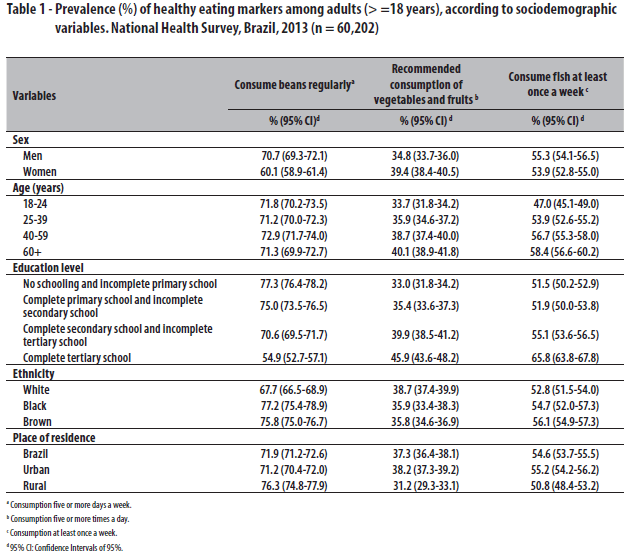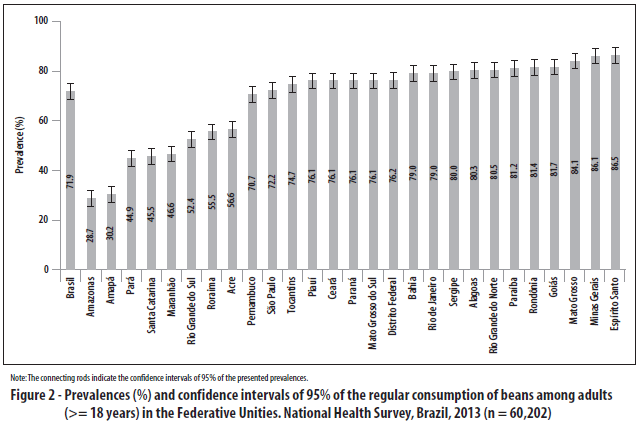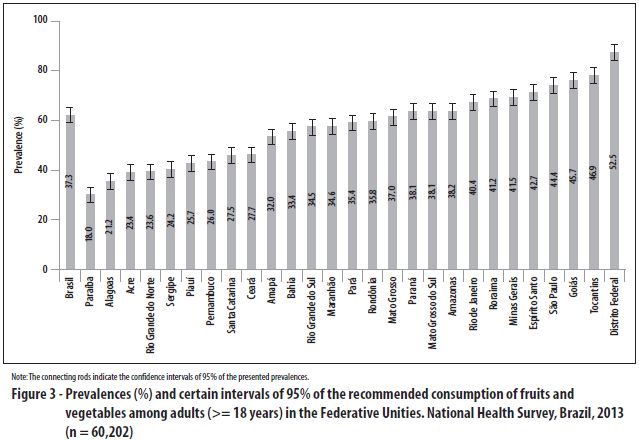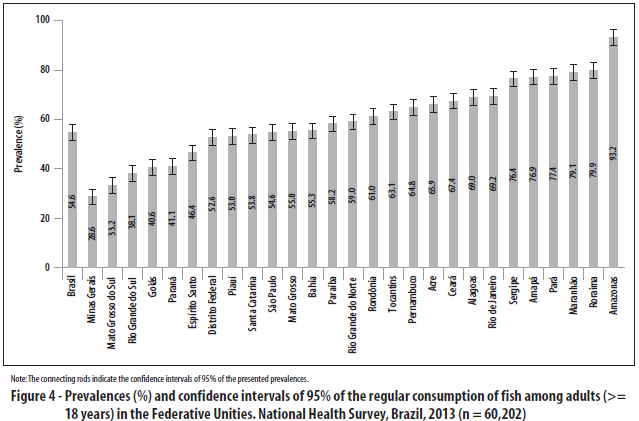Serviços Personalizados
Journal
Artigo
Indicadores
-
 Citado por SciELO
Citado por SciELO
Links relacionados
-
 Similares em
SciELO
Similares em
SciELO
Compartilhar
Epidemiologia e Serviços de Saúde
versão impressa ISSN 1679-4974versão On-line ISSN 2237-9622
Epidemiol. Serv. Saúde v.24 n.2 Brasília jun. 2015
http://dx.doi.org/10.5123/S1679-49742015000200009
ORIGINAL ARTICLE
Prevalence and sociodemographic distribution of healthy eating markers, National Health Survey, Brazil 2013
Patrícia Constante JaimeI,II; Sheila Rizzato StopaI,III; Taís Porto OliveiraIII; Maria Lúcia VieiraIV; Célia Landmann SzwarcwaldV; Deborah Carvalho MaltaIII,VI
IUniversidade de São Paulo, Faculdade de Saúde Pública, São Paulo-SP, Brasil
IIUniversidade de São Paulo, Núcleo de Pesquisas Epidemiológicas em Nutrição e Saúde, São Paulo-SP, Brasil
IIIMinistério da Saúde, Secretaria de Vigilância em Saúde, Brasília-DF, Brasil
IVInstituto Brasileiro de Geografia e Estatística, Diretoria de Pesquisas, Rio de Janeiro-RJ, Brasil
VFundação Oswaldo Cruz, Instituto de Comunicação e Informação Científica e Tecnológica em Saúde, Rio de Janeiro-RJ, Brasil
VIUniversidade Federal de Minas Gerais, Escola de Enfermagem, Belo Horizonte-MG, Brasil
ABSTRACT:
OBJECTIVE: to describe the prevalence of healthy eating markers and their association with sociodemographic variables
among Brazilian adults.
METHODS: cross-sectional study using data from the National Health Survey (PNS 2013) conducted in 64,348 households. Healthy eating markers evaluated
were: regular consumption of beans and fish and recommended consumption of fruit and vegetables. Prevalence (%) of these markers and their 95% confidence
intervals (95%CI) were estimated.
RESULTS: regular bean consumption was reported by 71.9% (95%CI: 71.2-72.6), fruit and vegetables by 37.3% (95%CI: 36.4-38.1) and fish by 54.6%% (95%CI:
53.7-55.5) of the population. Food marker distribution was influenced by age, sex, schooling, ethnicity and place of residence of respondents.
CONCLUSION: the findings confirmed a high prevalence of consumption of beans, fish and fruit and vegetables in the diet of Brazilian adults.
Key words: Food Habits; Food Consumption; Health Surveys; Epidemiology, Descriptive; Nutrition Surveys.
Introduction
The adequate diet and nutrition are basic requirements for the health promotion and protection and for a sustainable development.1 The World Health Organization (WHO) points to the necessity of improvement in the worldwide eating patterns for prevention, especially, of non-communicable chronic diseases.2 In Brazil, the inadequate diet, added to arterial hypertension and abusive consumption of alcohol comprise the three major risk factors that contribute for the burden of diseases in the country, according to data of the study on the Global Burden of Disease, 2010.3
Furthermore, the perspective of preventing health problems related to dietary factors, healthy eating is also recognized as an essential element for health and wellbeing promotion.1,4 In Brazil, as the right to Health, healthy eating is assured in the art. 6 of the Federal Constitution among the individual and collective social rights.5
The Health Ministry's Dietary Guidelines for the Brazilian population, updated in 2014, recommends, in the composition of a healthy diet,6 preferably, the consumption of food in natura or minimally processed, instead of ultra-processed products. Due to their appropriate profile of nutrients, low energetic density and the way they combine with other foods in the diet, composing adequate and healthy food preparations and meals, some groups of foods, such as fruits and vegetables, beans and fish, are recognized as markers of healthy eating patterns,2,7 and have been investigated in population surveys that bring information about eating.8-10
For preventing cardiovascular diseases, WHO recommends a daily intake of 400g/day of fruits and vegetables and to consume fish one to two times a week.2 The fruits and vegetables are also beneficial in the prevention and treatment of obesity,11 an emergent problem in the public health of Brazil.12 Regular beans consumption has also been associated to a healthy eating patterns for improving the supply of nutrients in the diet (higher amount of fibers and micronutrients, such as iron, potassium and magnesium), as well as for the reduction of the arterial blood pressure and the corporal weight control.13 Furthermore, considering the cultural dimension of eating, the beans are a traditional food of Brazilian culinary and, combined with rice, compose the base of lunch and dinner meals.14
Previous evidences, resulting of the Household Budget Survey (POF) of the Brazilian Institute of Geography and Statistics (IBGE), in the years 2008-2009, showed that the Brazilian eating patterns was characterized by the persistence of some traditional eating habits, as the consumption of fruits, vegetables and beans. However, an increasing and preoccupying participation of ultra-processed products in the diet is noticed.9,15,16
Given the intense processes of epidemiological and nutritional transition lived by the Brazilian population in the last few decades, it is necessary to update the information on food consumption and other behaviors to guide the outline and evaluation of interventions that aim to promote healthy ways of life which must take into account the population's current eating trend and patternss.17
In this sense, the objective of this article is to describe the prevalence of healthy food consumption markers and their association with sociodemographic variables among Brazilian adults, in 2013.
Methods
This is a cross-sectional study carried out from secondary data of the National Health Survey (PNS), a population-based survey led by IBGE in 2013, in a partnership with the Ministry of Health. The PNS is part of the Integrated System of Household Surveys (SIPD) from IBGE and uses the master sample of this system, which provides greater geographic scattering and accuracy gaining for specific health estimates. This is a representative sample of Brazil, its regions, urban and rural population and capitals.
It was a household research and the data collection occurred from August 2013 to February 2014. The sampling design used was a three-stage cluster sampling, with stratification of the primary units of sampling (UPA). The census tracts or set of sectors were the UPAs, the households were the secondary units and the residents aged 18 or older were the tertiary units. After ending the data collection, 64,348 household interview registers had been obtained, with 60,202 individuals interviewed, what resulted in a percentage of no reply of 8.1%.
Sample weights were defined for the UPAs, the households and all their residents, and the weight for the selected resident. This last one was calculated considering the weight of the corresponding household, the resident selection probability, adjustments of no reply by sex and calibration for the population totals by sex and age groups, estimated with all residents' weight. More details on the methodology, PNS sampling plan and balance factors can be obtained in previous publications.18,19
PNS investigated the eating habits of the Brazilian adults through markers of healthy and unhealthy eating patterns. The beans consumption was evaluated with inquiries about the weekly frequency of consumption (number of days in the week); the consumption of fruits and vegetables was evaluated with inquiries about the weekly and daily (number of times a day) frequency of consumption of vegetable salad, raw and cooked vegetable, fruits and natural fruit juice; the fish consumption was also evaluated regarding the weekly frequency.
The variables studied were: regular consumption of beans (consumption five or more days a week); recommended consumption of fruits and vegetables (consumption five or more times a day, in five or more days a week); and regular consumption of fish (at least once a week).
The variables studied were described according to the following sociodemographic variables: sex (men and women); age group (18-24, 25-39, 40-59 and 60 years and older); educational level (no schooling and incomplete primary school; complete primary school and incomplete secondary school; complete secondary school and incomplete tertiary school; and complete tertiary school); ethnicity (white, black and brown); place of residence (urban and rural); Brazilian regions (Central-West, South, Southeast, Northeast and North); and Federative Units (26 states and the Federal District).
The prevalences of the healthy eating consumption markers were estimated, presented in percentages (%), with their respective 95% confidence intervals (95%CI) for the total population and according to categories of sociodemographic variables. Data analyzes were performed through the software Stata version 11.0. The survey module was used for data analysis derived from complex sample.
The PNS was approved by the Ministry of Health's National Commission for Ethics in Research, under technical report n. 328,159, June 26, 2013. The Informed Consent in Research was signed.
Results
The regular consumption of beans was reported by 71.9% of Brazilian adult population (95%CI: 71.2-72.6), being higher among men (70.7%; 95%CI: 69.3-72.1), individuals with no schooling and incomplete primary school (77.3%; 95%CI: 76.4-78.2) and people with complete primary school and unfinished secondary school (75%; 95%CI: 73.5-76.5), in skin color black (77.2%; 95%CI: 75.4-78.9) and brown (75.5%; 95%CI: 75.0-76.7) and among those who live in the rural area (76.3%; 95%CI: 74.8-77.9). There was no statistically significant difference in the regular consumption of beans concerning age groups. As presented in Table 1, the distribution of the healthy eating markers is influenced by the population sociodemographic characteristics.

The recommended consumption of fruits and vegetables, when reported to be five or more times a day, was observed in 37.3% of the population (95%CI: 36.4-38.1), being statistically higher among women (39.4%; 95%CI: 38.4-40.5), individuals aged 60 or older (40.1%; 95%CI: 38.9-41.8), in the two higher education levels (39.9% when complete secondary school and incomplete tertiary school; 95%CI: 38.5-41.2; and 45.9% with complete tertiary school; 95%CI: 43.6-48.2), in individuals with white skin color (39.7%; 95%CI: 37.4-39.9) and among those who live in urban area (38.2%; 95%CI: 37.2-39.2). (Table 1)
The regular consumption of fish, reported to happen at least once a week, was present in 54.6% of the adult population studied (95%CI:53.7-55.5), being lower among younger people, 47% (95%CI:45.1-49.0); among people with no schooling and incomplete primary school, 51.5% (95%CI:50.2-52.9); and the residents in the rural area, 50.8% (95%CI:48.4-53.2) of the respondents. There were no statistical relevant differences concerning sex and among the categories of ethnicity, as presented in Table 1.
The Northern region presented higher prevalence of regular consumption of fish (77.2%; 95%CI:75.4-79.0) and lower regular consumption of beans (48.4%; 95%CI:46.1-50.7) among the five regions of the country. As for fruits and vegetables, the residents from the Central-West and Southeast had higher consumption prevalence, 43.9% (95%CI:42.0-45.9) and 42.8% (95%CI:41.3-44.4), respectively, as presented in Figure 1.

Besides the differences among the regions, it was observed relevant variations among the Federative Units. Regarding the regular consumption of beans, there was a difference in the States prevalence, which was higher in the state of Espírito Santo (86.5%; 95%CI:84.4-88.6), followed by Minas Gerais (86.1%; 95%CI:84.0-88.3), and lower in Amazonas (28.7%; 95%CI:26.0-31.3) and Amapá (30.2%; 26.5-33.9), as presented in Figure 2.

The Federal District presented higher prevalence on recommended consumption of fruits and vegetables, 52.5% (95%CI:49.2-55.8), with statistically relevant difference when compared to the other Federative Units. On the other hand, only 18.0% (95%CI: 14.7-21.3) of Paraíba residents reported consumption of these foods five or more times a day. It must be highlighted that the nine states of the Northeastern region presented prevalence of this healthy eating marker below the national prevalence observed (37.3%) (Figure 3).

We verified that the regular consumption of fish was significantly higher in the state of Amazonas (93.2%, 95%CI: 91.8-94.5) and lower in the states of Minas Gerais (28.6%; 95%CI: 24.8-32.5) and Mato Grosso do Sul (33.2%; 95%CI: 29.5-37.0). All the states of the Southern region (Rio Grande do Sul, Paraná and Santa Catarina) were among the nine Brazilian states with prevalence of regular consumption of fish below the national prevalence (54.6%), as presented in Figure 4.

Discussion
Based on the information obtained on the PNS 2013, it was possible to confirm that the Brazilian population diet still counts on the important role of foods that represent a healthy eating pattern. About three quarters of the population regularly consume beans. Barely more than one third of the population meets the recommendation proposed by the WHO for the consumption of fruits and vegetables (400 g/day, which is equivalent to the consumption of five portions/day), and slightly over half of the population meets the regular consumption of fish.
Similar results on the consumption of these healthy eating markers in the Brazilian adult population had been observed in previous population surveys.9,20,24 By using different methods to evaluate the food consumption and to present the dietary variables, the Household Budget Survey (POF) 2008-2009 described the participation of these foods in the average food availability in the Brazilian households, whereas fruits and vegetables contributed with 2.8% of the available calories for consumption, and beans and other legumes with 5.44%. The fish presented lower relative participation in the household availability of energy, 0.64%.9
In the comparative analysis between POFs 20022003 and 2008-2009 data, we can observe a decline in the energy contribution of beans and other legumes (-18%) and of fish (-9%), while the percentages of vegetables contribution remained relatively constant (0.8% in both periods) and the participation of fruits (+28%) in the diet have increased.9,20
By analyzing the PNS 2013 data, we observed that the food consumption of the Brazilian population aged 18 or older is determined by sociodemographic characteristics. However, when the three investigated eating markers (consumption of beans, fruits and vegetables and fish) are compared, we observe that there are different prevalences depending on the sociodemographic variables studied. The beans consumption, possibly for being a cheaper, basic and traditional food on the Brazilian population diet 9,15, was more frequent among the individuals with lower education level and rural areas residents. On the other hand, the consumption of fish, fruits and vegetables was more frequent among the individuals with complete tertiary school and urban area residents, possibly due to factors of access, availability and prices of these foods.8,21,22
The results of the present study confirm the different profiles of food consumption and the diverse eating habits that characterize the five country regions .9,15 For example, the North was distinguished for the highest prevalence of regular consumption of fish but also for the lowest prevalence of regular consumption of beans. In the group of fruits and vegetables, the positive prominence was in the Central-West and Southeast, with the highest prevalences of recommended consumption. Such regional differences in the distribution of the food markers are reinforced by previous analysis made by Levy et al9 based on the POF 2008-2009 data, that identified fish participation in household food availability almost ten times higher in the North compared to the Central-West and the South. Similarly to the observed in the PNS 2013, the household vegetable and legumes availability were lower in the North and Northeast and the beans had lower availability in the South of the country.
To understand regional and local differences in food consumption it is necessary to recognize the cultural heritage and historical value of the food, which are shaped in social and migration processes experienced over time; as well as the influence of multiple determinants on eating habit, such as the availability of the natural and economic resources.23
Brazil is a country of continental dimension, with great geographic (fauna and flora), economic and cultural diversity. Once the eating patterns are constituted by the combination of environmental, biological, social and cultural factors,4,6,23 the differences observed in the healthy eating markers distribution in the PNS are justified. In a similar way, the historical series of the Surveillance System of Risk and Protective Factors for Chronic Diseases by Telephone Survey (Vigitel), created by the Ministry of Health, also points differences in the distribution of eating markers in the Brazilian capitals.24 Besides, the occurrence of these markers low prevalence - for example, in the recommended consumption of fruits and vegetables in every state of the Northeast, that was below the national average, and in the regular consumption of fish in Minas Gerais, Mato Grosso do Sul and Rio Grande do Sul - points to the necessity of different investment in food and nutrition education and in programs of production, supplying, distribution and commercialization of foods in these places.
Since the release of the National Food and Nutrition Policy, in 1999, the advances in food and nutrition policies that aim to promote adequate and healthy eating and prevent obesity have been promising,17,25 as well as the specific actions in primary health care related to broadening access, care qualification26 and inequalities reduction.27
The data on food consumption of PNS 2013 reinforce that the Brazilian population consumes, with high prevalence, foods in natura and minimally processed as basis of their diet, as preconized by the new Dietary Guidelines for the Brazilian population.6 The food and nutritional surveillance, which is a set of strategies on epidemiological surveillance that supplies data on food and nutritional profile of the population,28 is essential to the formulation and implementation of policies, programs and actions of health promotion and food and nutrition security.
This study presents common limitations to the food consumption surveys, involving possible measurement bias in the usual diet due to the interviewee's memory failure, over or under-reporting of food consumption and limited validity of the data collection instruments.29,30 Furthermore, differences in methods to evaluate the diet and how to define and categorize food consumption variables may have compromised the comparability with other studies on population consumption of beans, fish and fruits and vegetables. On the other hand, the advantage of this study is the use of a representative sample of the Brazilian population aged 18 or more.
The PNS 2013 information on food consumption confirm high prevalence of food consumption which are markers of healthy patterns (consumption of beans, fruits and vegetables and fish), as well as enable a better understanding of sociodemographic factors related to Brazilian adults diet.
Authors' Contributions
All the authors participated in the conception, analysis and interpretation of the data, writing, revision, final approval of the article, and are responsible for all its aspects, including the guarantee of its accuracy and integrity.
References
1. International Food Policy Research Institute. Global nutrition report 2014: actions and accountability to accelerate the world's progress on nutrition [Internet]. Washington, DC: International Food Policy Research Institute; 2014 [cited 2014 Jan 30]. Available from: http://www.ifpri.org/sites/default/files/publications/gnr14.pdf
2. World Health Organization. Diet, nutrition and the prevention of chronic diseases: report of a joint WHO/FAO expert consultation [Internet]. Geneva: World Health Organization; 2003[cited 2014 Jan 30]. (WHO technical report series; 916) Available from: http://whqlibdoc.who.int/trs/who_trs_916.pdf
3. Institute of Health Metrics and Evaluation. GBD profile - Brazil: Global burden of diseases, injuries, and risk factors study 2010 [Internet]. Seattle, WA: Institute for Health Metrics and Evaluation; 2013 [cited 2014 Jan 30]. Available from: http://www.healthdata.org/sites/default/files/files/country_profiles/GBD/ihme_gbd_country_report_brazil.pdf
4. Contreras J, Gracia M. Alimentação, sociedade e cultura. Rio de Janeiro: Fiocruz; 2011. 496 p.
5. Brasil. Constituição, 1988. Constituição da República Federativa do Brasil [Internet]. Brasília: Senado Federal; 1988 [citado 2015 mar 10]. Disponível em: http://www.planalto.gov.br/ccivil_03/constituicao/constituicao.htm
6. Ministério da Saúde (BR). Secretaria de Atenção à Saúde. Departamento de Atenção Básica. Guia alimentar para a população brasileira. Brasília: Ministério da Saúde; 2014. 156 p.
7. World Health Organization. The World health report: 2002: reducing risks, promoting healthy life. Geneva: World Health Organization; 2002.
8. Jaime PC, Monteiro CA. Fruit and vegetable intake by Brazilian adults, 2003. Cad Saude Publica. 2005;21 Suppl 1:19-24.
9. Levy RB, Claro RM, Mondini L, Sichieri R, Monteiro CA. Distribuição regional e socioeconômica da disponibilidade domiciliar de alimentos no Brasil em 2008-2009. Rev Saude Publica. 2012 fev;46(1):6-15.
10. Malta DC, Iser BPM, Claro RM, Moura L, Bernal RTI, Nascimento AF, et al. Prevalência de fatores de risco e proteção para doenças crónicas não transmissíveis em adultos: estudo transversal, Brasil, 2011. Epidemiol Serv Saude [Internet]. 2013 set [citado 2015 mar 10];22(3):423-34. Disponível em: http://scielo.iec.pa.gov.br/scielo.php?script=sci_arttext&pid=S1679-49742013000300007&lng=pt
11. Alinia S, Hels O, Tetens I. The potential association between fruit intake and body weight: a review. Obes Rev. 2009 Nov;10(6):639-47.
12. Instituto Brasileiro de Geografia e Estatística. Pesquisa de orçamentos familiares 2008-2009: antropometria e estado nutricional de crianças, adolescentes e adultos no Brasil. Rio de Janeiro: Instituto Brasileiro de Geografia e Estatística; 2010.
13. Papanikolaou Y, Fulgoni VL 3rd. Bean consumption is associated with greater nutrient intake, reduced systolic blood pressure, lower body weight, and a smaller waist circumference in adults: results from the National Health and Nutrition Examination Survey 1999-2002. J Am Cool Nutr. 2008 Oct;27(5):569-76.
14. Barbosa L. Feijão com arroz e arroz com feijão: o Brasil no prato dos brasileiros. Horiz Antropol. 2007 jul-dez;13(28):87-116.
15. Souza AM, Pereira RA, Yokoo EM, Levy RB, Sichieri R. Alimentos mais consumidos no Brasil: Inquérito Nacional de Alimentação 2008-2009. Rev Saude Publica. 2013 fev;47 supl 1:190-9.
16. Martins APB, Levy RB, Claro RM, Moubarac JC, Monteiro CA. Participação crescente de produtos ultraprocessados na dieta brasileira (1987-2009). Rev Saude Publica. 2013 ago;47(4):656-65.
17. Jaime PC, Santos LMP. Transição nutricional e a organização do cuidado em alimentação e nutrição na atenção básica em saúde. Divulg Saude Debate. 2014 out;51:72-85.
18. Instituto Brasileiro de Geografia e Estatística. Pesquisa Nacional de Saúde 2013: percepção do estado de saúde, estilos de vida e doenças crónicas. Rio de Janeiro: Instituto Brasileiro de Geografia e Estatística; 2014.
19. Szwarcwald CL, Malta DC, Pereira CA, Vieira MLFP, Conde WL, Souza Júnior PRB, et al. Pesquisa Nacional de Saúde no Brasil: concepção e metodologia de aplicação. Cienc Saude Coletiva. 2014 fev;19(2):333-42.
20. Levy-Costa RB, Sichieri R, Pontes NS, Monteiro CA. Disponibilidade domiciliar de alimentos no Brasil: distribuição e evolução (1974-2003). Rev Saude Publica. 2005 ago;39(4):530-40.
21. Figueiredo ICR, Jaime PC, Monteiro CA. Fatores associados ao consumo de frutas, legumes e verduras em adultos da cidade de São Paulo. Rev Saude Publica. 2008 out;42(5):777-85.
22. Duran AC, Diez-Roux AV, Latorre MRDO, Jaime PC. Neighborhood socioeconomic characteristics and differences in the availability of healthy food stores and restaurants in São Paulo, Brazil. Health Place. 2013 Sep;23:39-47.
23. Ministério da Saúde (BR). Alimentos regionais brasileiros. 2. ed. Brasília: Ministério da Saúde; 2014.
24. Ministério da Saúde (BR). Departamento de Informática do SUS. Vigilância de fatores de risco e proteção para doenças crónicas por inquérito telefónico: notas técnicas[Internet]. Brasília: Ministério da Saúde [citado 2015 fev 2]. Disponível em: http://tabnet.datasus.gov.br/cgi/vigitel/vigteldescr.htm
25. Jaime PC, Silva ACF, Gentil PC, Claro RM, Monteiro CA. Brazilian obesity prevention and control initiatives. Obes Rev. 2013 Oct;14 Suppl 2:88-95.
26. Magalhães Jr HM, Pinto HA. Atenção básica enquanto ordenadora da rede e coordenadora do cuidado: ainda uma utopia? Divulg Saude Debate. 2014 out;51:14-29.
27. Jaime PC, Amaral MA, Magalhães Jr HM. Ações de saúde no plano Brasil sem miséria: o acesso à saúde orientado pela superação de iniquidades. In: Campello T, Falcão T, Costa PV, organizadores. O Brasil sem miséria. Brasília: Ministério do Desenvolvimento Social; 2014.
28. Coutinho JG, Cardoso AJC, Toral N, Silva ACF, Ubarana JA, Aquino KKNC, et al. A organização da vigilância alimentar e nutricional no Sistema Único de Saúde: histórico e desafios atuais. Rev Bras Epidemiol. 2009 dez;12(4):688-99.
29. Medlin C, Skinner J. Individual dietary intake methodology: a 50-year review of progress. J Am Diet Assoc. 1988 Oct;88(10):1250-7.
30. Scagliusi FB, Ferriolli E, Pfrimer K, Laureano C, Cunha CS, Gualano B, et al. Underreporting of energy intake in brazilian women varies according to dietary assessment: a cross-sectional study using doubly labeled water. J Am Diet Assoc. 2008 Dec;108(12):2031-40.
 Correspondence:
Correspondence:
Patricia Constante Jaime
- Departamento de Nutrição,
Faculdade de Saúde Pública,
Universidade de São Paulo.
Avenida Dr. Arnaldo, 715.
São Paulo-SP. CEP: 01246-904.
E-mail: constant@usp.br
Received on 09/02/2015
Approved on 17/03/2015











 texto em
texto em 
 Curriculum ScienTI
Curriculum ScienTI
